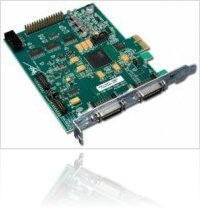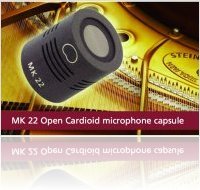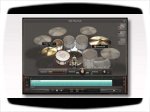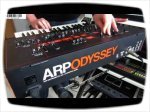Mac and Music News
Through Thursday February 19, 2009
| Oct 27 - 04:29 PM | Computer Hardware > Apogee Electronics |
 Apogee Electronics announces that the Symphony 64 is now shipping worldwide to authorized dealers and distributors. Symphony 64 is a 64 channel, 24bit/192kHz PCI Express card made to interface Apogee's X-Series and Rosetta Series converters directly to Apple's Mac Pro creating The Symphony System.
Apogee Electronics announces that the Symphony 64 is now shipping worldwide to authorized dealers and distributors. Symphony 64 is a 64 channel, 24bit/192kHz PCI Express card made to interface Apogee's X-Series and Rosetta Series converters directly to Apple's Mac Pro creating The Symphony System.
Features Highlight :
- 64 channels of 24-bit 192kHz Digital I/O per card
- Up to 128 channels of I/O per Mac Pro
- Near zero latency performance
- Connects directly to Apogee's X-Series and Rosetta Series converters via the X-Symphony option card
- Apogee's VBus - virtual routing within a Core Audio application or between multiple applications.
- Apogee's SBus - 32 channel, 192kHz digital audio network between two Mac computers
- Apogee's Maestro Software for advanced control and rout ...
| Oct 27 - 03:38 PM | Audio Hardware > PreSonus |
 PreSonus has just announced that they are now shipping their brand new Studio Channel, a channnel strip which combines a tube-based, Class A mic/instrument preamplifier, a VCA-based compressor and a three-band parametric equalizer.
PreSonus has just announced that they are now shipping their brand new Studio Channel, a channnel strip which combines a tube-based, Class A mic/instrument preamplifier, a VCA-based compressor and a three-band parametric equalizer.
Features :
- Class A vacuum tube microphone / instrument preamplifier
- Tube gain and tube drive
- Variable VCA compressor (threshold, ratio, attack, release, make up gain, auto, soft)
- Three-band parametric EQ
- Precision analog VU meter for gain reduction and output
- EQ Pre/Post compressor switch
- 80Hz high pass filter
- 20dB pad
- Phase invert
- Rugged metal chassis
- High headroom
- Ultra low noise design
The Studio Channel is available now and is priced at MSRP $359 (street price $299).
| Oct 27 - 10:47 AM | Plug-ins > Expert Sleepers |
 Expert Sleepers has just released Augustus Loop v2.0 which is a major update to the tape echo/looping plug-in.
Expert Sleepers has just released Augustus Loop v2.0 which is a major update to the tape echo/looping plug-in.
Features :
- Augustus Loop's GUI is now fully skinnable and scriptable.
- MIDI behaviour is now scriptable.
- VST version now receives MIDI.
- Added Record Offset feature.
- Added waveform display.
- The 'Max Delay Time' parameter now has a smaller minimum value (1.0 seconds) and is not rounded to the nearest 10 seconds.
- Added Tape Read Mode parameter.
- The Freeze Loop function is much improved.
- A small crossfade is now applied when activating Clear Loop, and when Clear Loop ends.
- The Input Level parameter is now protected against sudden changes, which previously could result in audio artefacts. In particular this makes the Punch In/Out features more usable.
- A small crossfade is now applied when activating Tap Record.
- Added a new mode for the Freeze Loop function, "Freeze Current".
- Added OSC support.
- Added 'Sync Group' feature.
- Added new 'Tape Sim' section.
- Added factory presets.
- Fixed a bug that could cause Digital Mode to not engage correctly.
Augustus Loop v2.0 is available now for Mac (AU/VST) and PC (VST). It costs $49 and a registration allows you to install the plug-in on up to three computers at once. v2.0 is a $20 upgrade from v1.5 or higher; it is a $29 upgrade from previous versions.
| Oct 25 - 12:47 PM | Audio Hardware > Schoeps Microphones |
 Schoeps unveils the MK 22 microphone capsule which features a new kind of directional pattern: "Open Cardioid".
Schoeps unveils the MK 22 microphone capsule which features a new kind of directional pattern: "Open Cardioid".
The MK 22 has been developed for use as a spot microphone. It unites the strengths of the MK 4 and MK 21 capsules. Its directionality is only slightly less than that of the MK 4 cardioid, while its sonic character is reminiscent of the MK 21 wide cardioid. Its directivity is essentially constant throughout the frequency range. Its inherent low-frequency response is somewhat more pronounced than that of the cardioid, while proximity effect is somewhat less.
The "Open Cardioid" directional pattern, occupying a point on the spectrum between the wide cardioid and classic cardioid patterns, was developed by SCHOEPSin 2008. The response is -5 dB at 90° and there is 16 dB suppression of rear-incident sound. It is in essence a variant cardioid which balances a very natural sound quality with a good degree of directionality.
| Oct 25 - 10:47 AM | Audio Hardware > Black Lion Audio |
 Black Lion Audio has released the Auteur Mic Preamp, a new 2 channel microphone preamp. What makes this preamp so special ? In their own words :
Black Lion Audio has released the Auteur Mic Preamp, a new 2 channel microphone preamp. What makes this preamp so special ? In their own words :
"For one, it's a design that's somewhat unique in its approach. Being admirers of the fully balanced transformer-less circuits found in many of the great recording consoles, we chose to use a similar topology. We began with a high speed input stage that would pick up lots of detail and nuance, and then followed it with a high current output stage. Circuit headroom is plentiful, and the input stage is very difficult to clip. Because of its fully balanced design, it can handle input signals as large as +15dB with ease.
We also like classic transformer-based designs because of the characteristic they lend to the audio signal. Because of this, ...











